The Prairie State is a great place for birdwatching, with 2 national forests, 5 state forests, and 43 parks where our fine feathered friends can forage and frolic. There are a lot of birds that you can see in Illinois and that will be our focus today. We’ll give you a little information about what these birds look like, where to find them, how to lure them and more! Let’s talk about the popular backyard birds of Illinois!
3 Categories – 400+ Birds
With a little over 400 species present, things would get pretty crowded here and even the most dedicated birder might have to bookmark the page and come back later. To keep things simple and fun, we’re taking a sampling of birds and dividing them up seasonally, so that you have a handful to look for at any given time. We’ll divide them up like this:
- Year-round Resident birds
- Birds of Spring, Summer, and Early Fall
- Fall and Winter Birds
We’ll give you the information that you need to identify them and lure them but no promises! Their personalities vary, as you well know, and while some are bold other birds are as shy as they are graceful. So set up your feeder but be patient. The wait is always worth it.
Illinois’s Year-Round Resident Birds
The birds that we have selected for this category have made Illinois their year-round home. This means that you can see them just about any time, provided that you know where to look or how to properly set up your feeder. Keep an eye out this year and you might see one of these birds:
- White-breasted Nuthatch
- Blue Jay
- House Finch
- Black-capped Chickadee
- American Goldfinch
White-breasted Nuthatch – Sitta carolinensis

Coloration and Markings: The White-breasted Nuthatch has blue-gray back, wings, and tail with a handful of small black feathers accenting the blue and very minor white edging. The breast and underbelly are snow-white, with the exception being a distinctive orange-brown marking right around the rump. Facially, this bird has a white face with a black line travelling from the back of the eye to the back of the head and a gray or black cap which extends down to the back. These birds have long, straight bills which are typically black on top and gray on the bottom.
Size: This bird measures in at 5.1 – 5.5 inches in length with a wingspan of 7.9 to 10.6 inches.
Habitat: These birds love older forests and are especially fond of certain trees, such as Oak or Hickory. They spend their time either deep in the woods or playing at the forest’s edge but they will venture forth to visit backyard feeders.
Diet: The White-breasted Nuthatch will visit a feeder if you have suet, peanuts, and Black Oil Sunflower seeds.
Blue Jay – Cyanocitta cristata
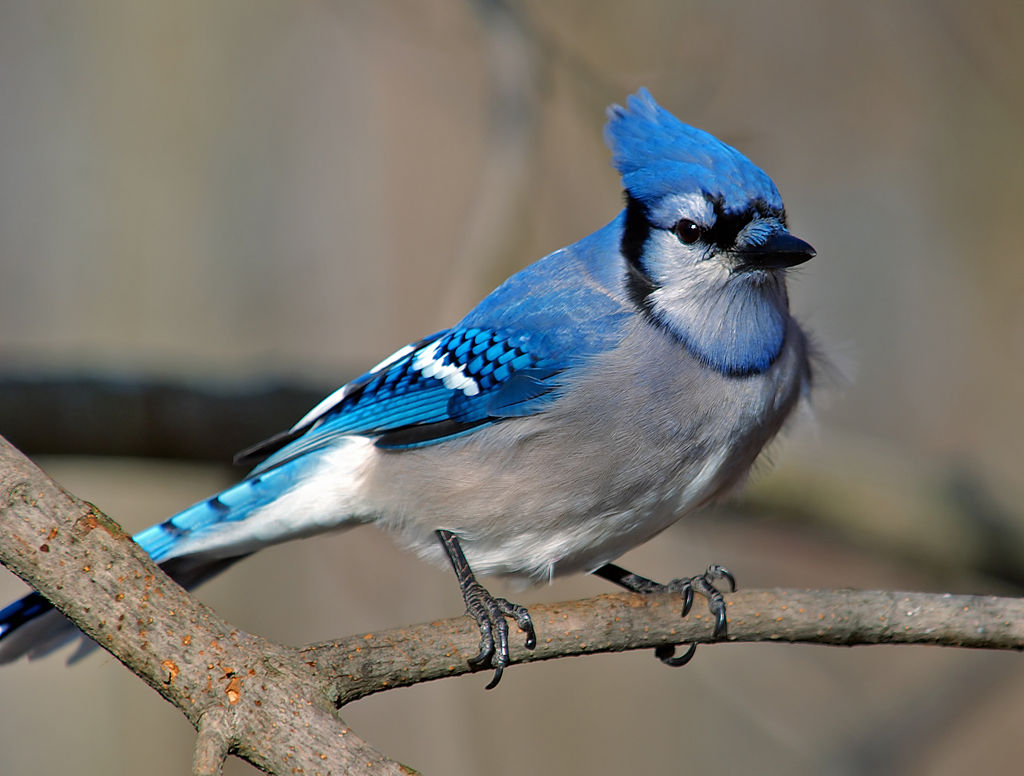
Coloration and Markings: Blue Jays are quite stunning, with blue backs, wings, and long, blue tails. The wings each have a white wingbar, with a ‘scale’ effect around them of black-outlined lighter shades of blue. Additional white spots decorate the mostly-blue wings and the scaling pattern continues to the tail, with larger square ‘scales’ with an almost white blue in the center. The breast and underbelly of this bird, by contrast, are a paper-white and this bird’s face is framed with a black line which travels from the back of the head to the other side. Facially, the bird has a white face and a large, light blue crest, and it sports an ‘abstract’ mask that covers the eye and spreads like a tree branch in front of it, while the back of the mask is a straight line terminating at the black line which isolates the face. These birds have long, straight black bills.
Size: These birds measure in at 9.8 – 11.8 inches from head to tail and have wingspans of 13.4 to 16.9 inches.
Habitat: When they are not frequenting the forest’s edge, these birds are quite urbanized, spending times in parks, cities, and especially backyard feeders in those cities.
Diet: These birds like suet, peanuts, and Black Oil Sunflower seeds so be sure to stock up the feeder with these if you spot a local Bluejay. You might just make a new friend.
House Finch – Haemorhous mexicanus
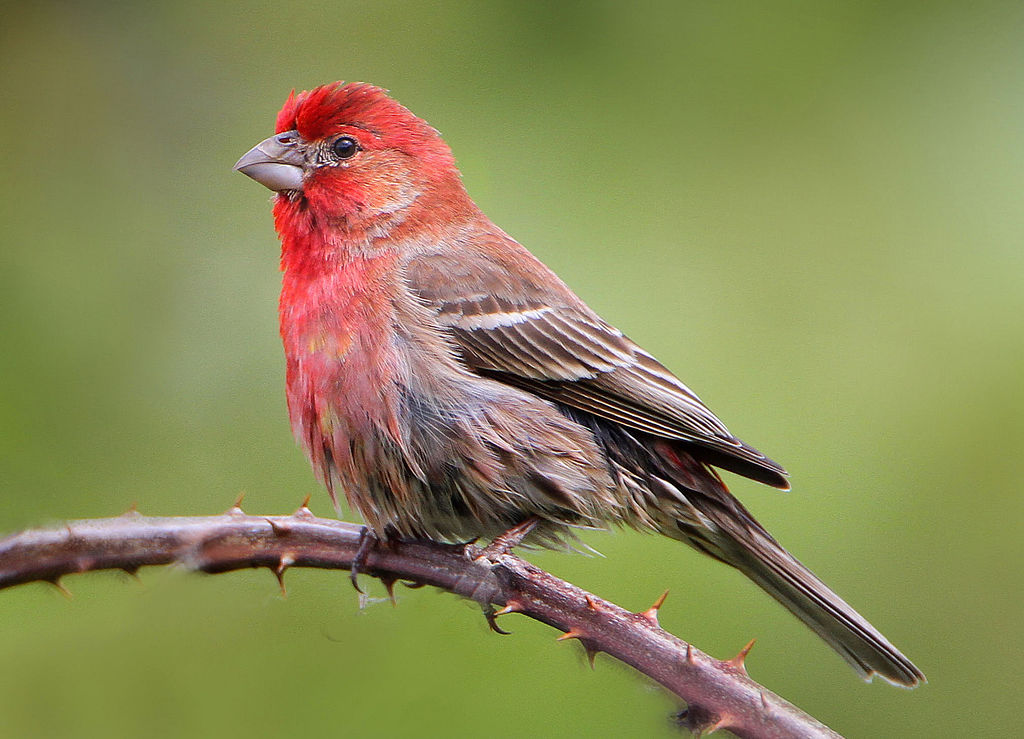
Coloration and Markings: Male House Finches are pretty little guys. They have brown or gray backs, wings, and medium-sized tails with the wings sporting vertical black streaking with 2 wingbars on each wing. The breast is a rosy red and gray which turns to white with dark streaking as it goes to the underbelly and facially these birds have rosy faces with gray skin around the eyes and typically with 1 or 2 ‘zigzag’ gray lines in the plumage. These birds have small, stout gray bills with a slight curve.
Size: These birds measure in at 5.5 – 5.5 inches in length with wingspans of 7.9 to 9.8 inches.
Habitat: Like the Blue Jay, House Finches are quite acclimated to our society and when they aren’t at the forest’s edge they enjoy spending time in parks, farms, and backyards. They’ll come to your feeder but you will want to stock well – they like to travel in flocks!
Diet: Insects and fruits are this bird’s primary fare in the wild, so try adding mealworms and some berries (dried or fresh, fresh is best) to your feeder. You might just get the House Finche’s full attentions.
Black-capped Chickadee – Poecile atricapillus
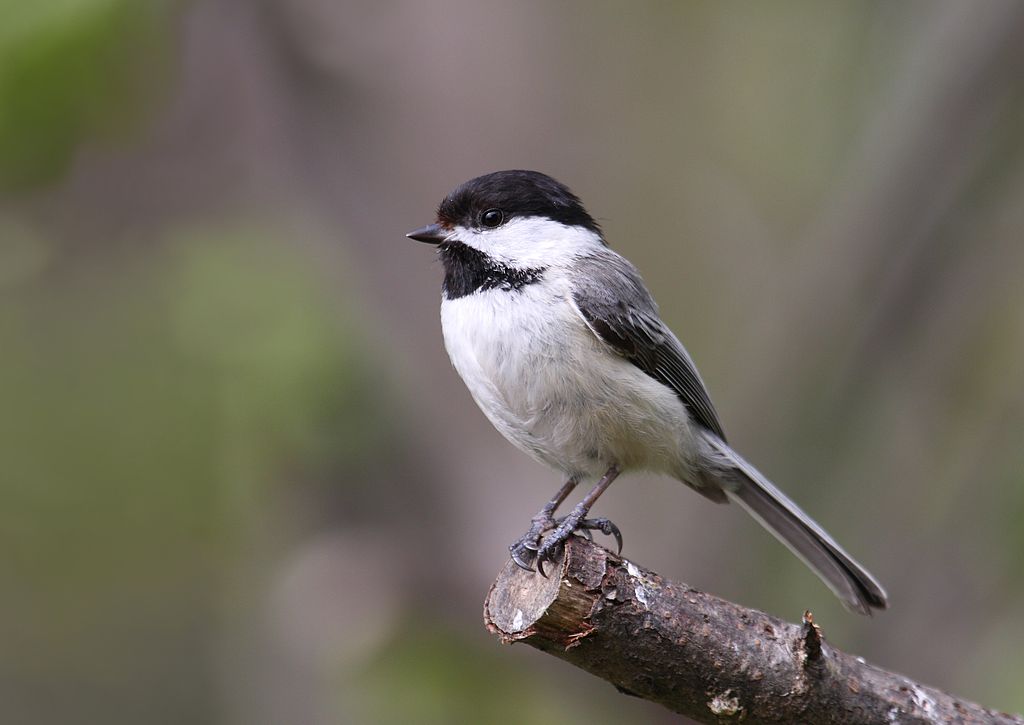
Coloration and Markings: The Black Capped Chickadee has light gray back, wings, and medium-sized tail with some white highlighting in the form of minute feather edging. This bird has a white breawt and underbelly with a buff shading flanking the sides and facially, a black bib with a white face and a large black cap that terminates just under the eyes. The birds have small, conical black bills.
Size: These birds measure in at 4.7 – 5.9 inches from tip to tail with wingspans of 6.3 to 8.3 inches.
Habitat: This bird loves the woods but any place with dense vegetation such as brush or shrubs is also a welcome habitat. Marshes are also popular with this bird, provided they have cover to let the Black-capped Chickadee feel safe.
Diet: Peanuts and peanut butter are welcome feeder-foods for this bird but they also like Black Oil Sunflower seeds and suet.
American Goldfinch – Spinus tristis

Coloration and Markings: The American finch has a simple, lovely plumage scheme that makes them easy to identify. Spring males have bright yellow backs and the shoulder portions of their wings are yellow while the remaining portions of the wing are black with a white wingbar on each wing, some vertical white striping mid-wing, and assorted white marking on a long, black tail. They have a yellow breast and underbelly, with some white starting at the rump which continues to the underside of the tailfeathers. Facially, these birds have yellow faces and small, orange conical bills, as well as a distinctive black cap from the top-center of the head down to the bill. Females have similar coloration, albeit with duller yellows and olive-gray instead of the black displayed by the male. In winter these birds change to a dull brown color but may still be identified by their bills and their dim, but still-present wingbars.
Size: These little guys measure in at 4.3 – 5.1 inches in length with wingspans of approximately 7.5 to 8.7 inches.
Habitat: These birds love thistles, so any field with a lot of weeds is likely host to a handful of these birds. They are not shy about inhabited areas either, ranging often into orchards, gardens, and backyards where feeders have been stocked for their pleasure.
Diet: The American Goldfinch is easy to please, just add ample quantities of Nyjer thistle and suet to your feeders and once they see it then you will likely have some visitors.
Illinois’s Birds of Spring, Summer, and Early Fall
These birds love Montana but they hate the winters (they’re not for everyone, as you know). Until it’s starts to get frosty, however, they play and fall in love in various locales throughout Montana’s diverse climates. Only 4 backyard birds fit this category and while we realize there are some others you might see, those are likely year-rounders. Montana’s birds of Spring, Summer, and early Fall to look for are:
- Northern Parula
- Purple Martin
- Eastern Wood-Peewee
- House Wren
- Gray Catbird
Northern Parula – Setophaga americana

Coloration and Markings: Northern Parulas have beautiful coloration, with yellow-green backs and blue gray wings, with 2 white wingbars on each wing and dark gray, black, and white accenting the wings towards the tips. These birds have short, animated blue-gray and black tails and they have a yellow breast with a rich, brown band marking a distinctive line between the breast and the throat. The have white underbellies and the undersides of their tails are white as well and facially, they have yellow chins with most of the remainder of the face being a richer blue-gray. The exceptions are a white eyering is distinctly present but only partial, showing as a small curved line above the eye and a larger one below it and a wide, black line from the bill to the front of the eye. This bird has a straight, medium-sized black and yellow bill. Females and juveniles are similar but their colors are muted a bit and they lack the brown band on the upper breast.
Size: These diminutive creatures measure in at 4.3 – 4.7 inches in length with wingspans of 6.3 to 7.1 inches.
Habitat: Evergreen and deciduous forests are favorite haunts for these tiny beauties. They are attracted to moss and so this is what you need to look for if you are out hiking and wish to spot a Northern Parula. Towards winter they start ranging as they forage and they start spending more time in fields, parks, and the occasional backyard.
Diet: While these birds generally do not visit feeders, they have been known to seek out nectar, berries, and seeds in the winter and they sometimes visit backyards with shrubs or other dense cover. You can try to tempt the bird with some Black Oil Sunflower seeds, assorted berries, and sugar water in a hummingbird feeder and it might work but we can’t make any promises.
Purple Martin – Progne subis
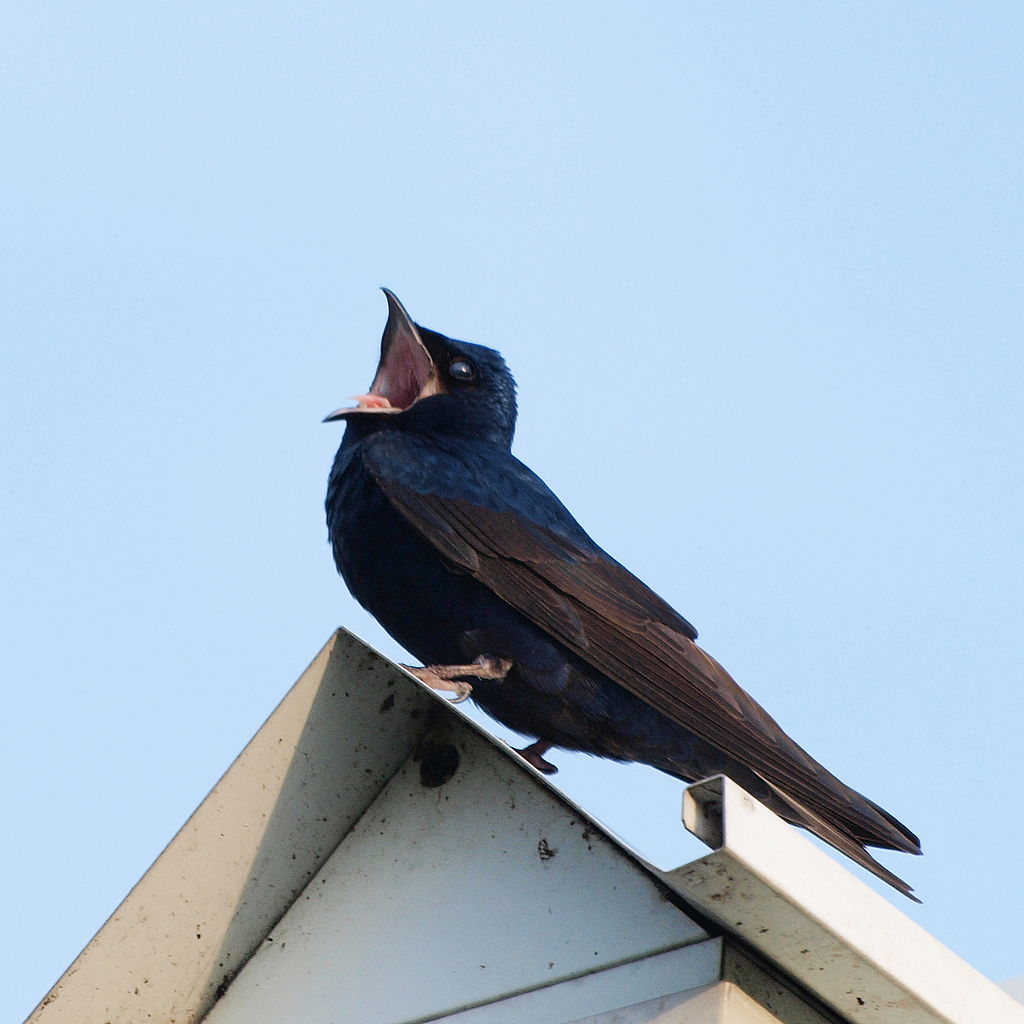
Coloration and Markings: Purple Martins are quite striking, with dark blue back and shoulders and long, black wings and tail. Their breast is mostly blue with some black added as you descent to the black and blue underbelly. Facially, this bird has a blue-black chin and a deeper blue coloration starting at cheek level and continuing up, with the only break in this being a diamond-shaped black mask in front of a small, curved black bill. Females and juveniles have a duller coloration with spots of gray on top and some white tufts below.
Size: The largest North American Swallow, these birds measure in at 7.5 – 7.9 inches in length with wingspans of 15.3 to 16.1 inches.
Habitat: Purple Martins are attracted to water and open areas, such as fields, farms, and parks. They tend to travel in numbers so if you spot one there are likely more around. Be sure to prepare accordingly if you would like a visit.
Diet: They are primarily insectivores but there are two methods for getting their attention. First, you can throw cooked egg within their line of sight to ‘cue’ them and afterwards leave it in your feeder from time to time and this SOMETIMES works. They are a little shy about feeders but once they know they can get eggs you have a foot in the door. Secondly, you can put crushed eggshells in the feeders which reputedly aid in digestion and can attract them in this manner.
Eastern Wood-Peewee – Contopus virens
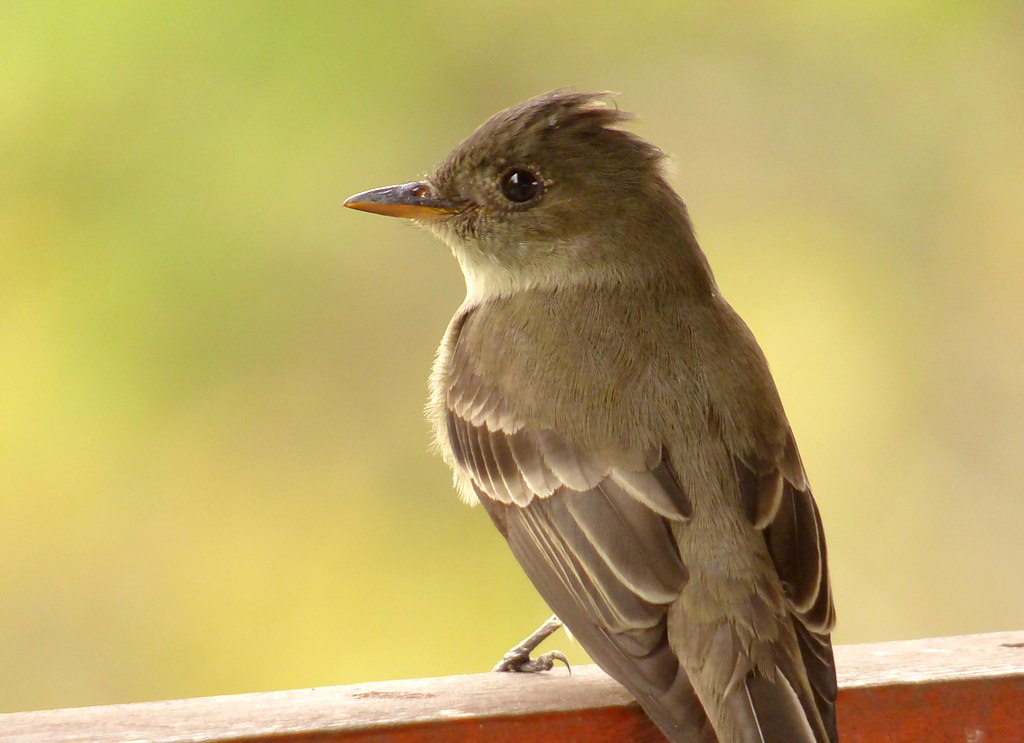
Coloration and Markings: The Eastern Wood-Peewee has a dark gray back, wings, and long, rounded gray tail. Some white edging and thin, white wingbars (on males) accentuate the wings. These birds also have a white breast and underbelly, heavily flanked with gray so that the white is central but not on the sides. Facially, they have light gray chins while the rest of the face is a darker gray. Sometimes you will see faint tracings of an eyering but not always and these birds have long, straight gray and orange bills.
Size: This bird measures in at approximately 5.9 inches with a wingspan of 9.1 to 10.2 inches.
Habitat: These birds may be found in any kind of forest but they do prefer deciduous ones. These birds will visit other places, however, but typically there needs to be trees for them to feel comfortable.
Diet: These flycatchers tend to ignore feeders, being mostly insectivorous, but they might respond to them if you leave out berries or visit if you have berry bushes.
House Wren – Troglodytes aedon
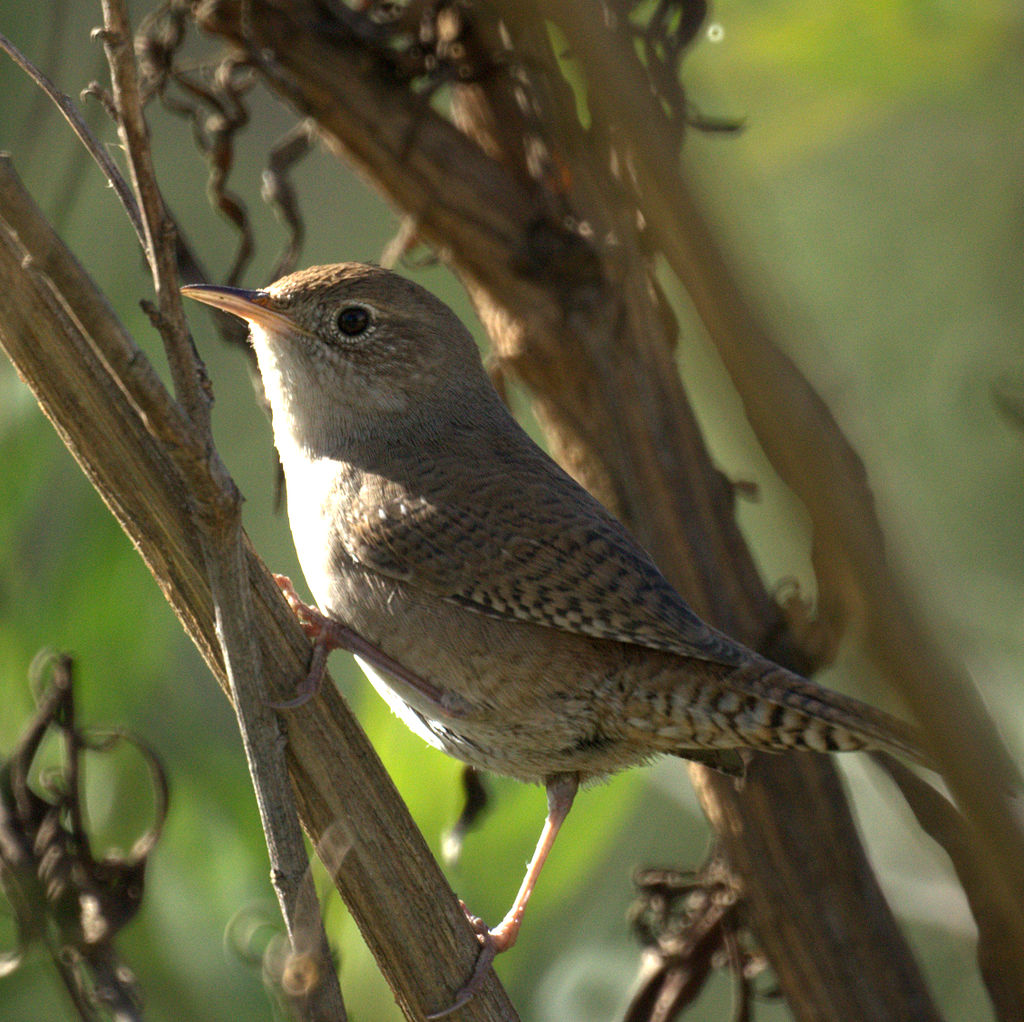
Coloration and Markings: House Wrens have a brown back, wings, and a short brown tail. The wings exhibit some dark barring on the lower half that is also present on the tail. The breast and underbelly of these birds is a light-brown which darkens as it reaches the rump and facially, these birds have a brown face with a thin eyebrow line and some white accenting to the cheeks. They have long, slightly curved black bills.
Size: These little Wrens measure in at 4.3 – 5.1 inches in length with wingspans of approximately 5.9 inches.
Habitat: In the warm months these birds like open areas, such as the forest’s edge, fields, parks, and backyards, but when it gets colder then they tend to spend time in the cover of brush and shrubs.
Diet: These birds are very shy about feeders but most Wrens may be tempted by peanut butter, peanuts, suet, mealworms, and dried crickets.
Gray Catbird – Dumetella carolinensis

Coloration and Markings:
Size: Roughly Robin-sized, these birds measure in at 8.3 – 9.4 inches in length with a wingspan of 8.7 to 11.8 inches.
Habitat: These birds love the cover of shrubs and thickets but they are no strangers to open areas as well, such as parks or fields. They are also attracted to water and it is not uncommon to see them foraging next to rivers or streams.
Diet: Gray Catbirds are very fond of fruit, so try adding chopped apples or assorted dry fruits in your feeder to attract them. If you have a garden with fruiting plants then your chances are even better for a visit, so consider adding some blackberry vines or other fruiting plants you don’t have them already for best results.
Illinois’s Fall and Winter Birds
Winters can get a little chilly, dropping as low as the 20’s if you live in the Southern portions of Illinois. That doesn’t stop these birds, however, who are hardy, happy, and waiting to visit your feeder! Let’s take a closer look at the following Illinois winter birds:
- Northern Shrike
- White-winged Crossbill
- American Tree Sparrow
- Northern Cardinal
- European Starling
Northern Shrike – Lanius borealis

Coloration and Markings: Northern Shrikes have gray backs and some gray towards the tips of their wings, with the rest darkening as the coloration moves towards the back. These birds have a white wingbar on each wing and their long tails are gray and black on top with white on the undersides. The breast and underbelly of this bird are white and this white continues up into the face until just under the bill. It spreads horizontally, leveling in such a way as to frame the cheek, terminating at the blue coloration which takes up the rest of the head as well as the black mask which starts at the beginning of the eye and passes on until just shy of the back of the head. This bird has a stout, curved black beak. Juveniles vary a little from adults in appearance, with brown instead of black in their coloration, a fainter mask, and more prominent wingbars.
Size: Thesebirds measure in at 9.1 – 9.4 inches in length with wingspans of 11.8 to 13.8 inches.
Habitat: Open areas are where this bird is most comfortable and it favors boreal forests in particular. Any dense vegetation can be a host to this bird as well, so look for them also near or in thickets or shrubs.They might well visit your backyard but keep in mind that they could prey on other birds that do as well.
Diet: Unfortunately the only lure in your feeder for Northern Shrikes is other birds eating there. These birds are predators who prefer to hunt for their food.
White-winged Crossbill – Loxia leucoptera

Coloration and Markings: White-Winged Crossbills havr lovely coloration, with rosy-red backs streaked with black and black wings and tail. The wings have 2 white wingbars present and white markings down the center as they approach the tail. The tail has only minor white accenting and the breast and sides of this bird are rosy-red, changing often to rose and gray as the color approaches the underbelly. Facially, these birds are rose-red with grayish-black skin around the eye and bill, and some black marking often present around the cheek and directly behind the eye. These birds have short, stout silver bills with a noticeable curve.
Size: These birds measure in at 5.9 – 6.7 inches in length with wingspans of 10.2 to 11 inches.
Habitat: These birds are known to be fond of Tamarack and Spruce, the seeds of which they enjoy eating when spending time in boreal forests. You can also find them in open areas such as fields, parks, and the occasional backyard.
Diet: White-winged Crossbills eat insects, seeds, and fruit, so try adding chopped apples, mealworms, and Black Oil Sunflower seeds to lure these birds in for a backyard visit.
American Tree Sparrow – Spizella arborea

Coloration and Markings: American Tree Sparrows have gray backs, wings, and tails which are streaked with brown. They have 2 distinctive white wingbars on each wing and their breast and underbelly is grayish-white, with some soft brown color flanking it. It is not uncommon to see a large brown splotch at the center of the breast but this will not always be present. These birds have gray faces, with some white minor white highlighting under the bill as well as a brown eyeline travelling from under the eye and out the back of it, stopping just short of the back of the head. These birds have a rust-red cap and short, black and yellow bills.
Size: These birds have an overall length of approximately 5.5 inches and wingspans averaging 9.4 inches.
Habitat: These birds love hedges, brambles, thickets, and shrubs but they may also be found in untended fields or at the forest’s edge. They readily visit backyards as well, so be sure to leave a little something out for them.
Diet: When they aren’t eating insects, these birds like small fruits and seeds. Try adding some fresh whole or chopped cherries, strawberries, or blackberries to your feeder along with some Black Oil Sunflower seeds. These little guys will love you for it.
Northern Cardinal – Cardinalis cardinalis
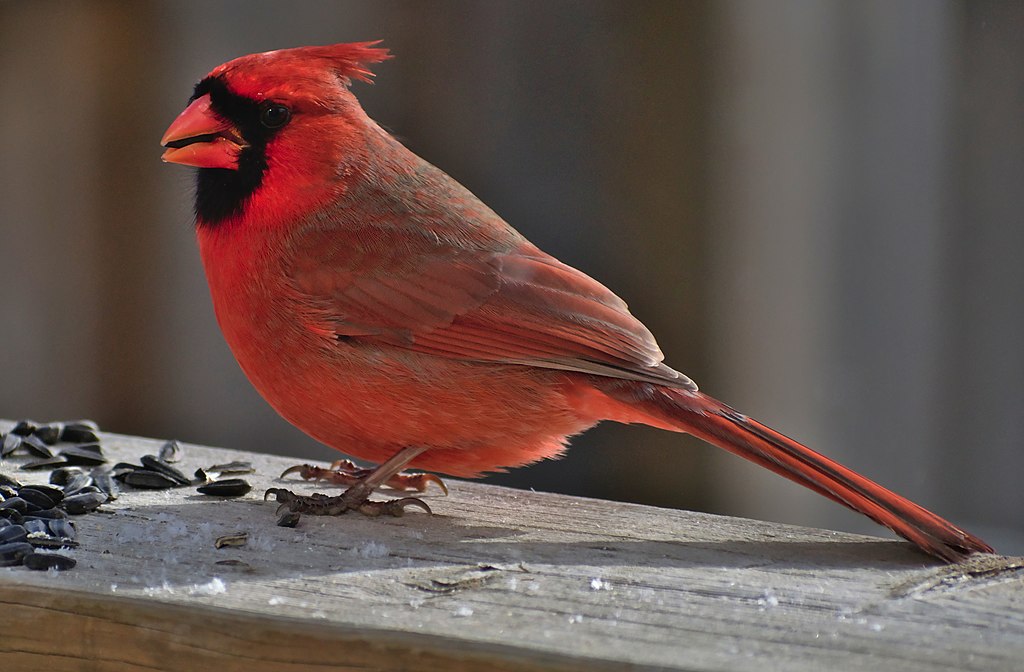
Coloration and Markings: The State Bird of Illinois, Northern Cardinals are easy to identify and no less stunning for it. Almost the entire plumage of this bird is a striking red color, though sometimes you will see some scattered grays in the wings or tail. This bird also has a black mask which covers the eyes and continues down to the chin, highlighting it’s stout, conical orange bill, and atop its head is a lovely, very-noticeable red crest. Females will get your attention as well but their coloration is quite different, as they have a light brown overall coloration with some tinges of red in their crest and other areas over their body.
Size: These birds are 8.3 – 9.1 inches from head to tail with wingspans of 9.8 to 12.2 inches.
Habitat: These birds like the edge of the forest but they also love the city, where you cansee them perched on fences or telephone lines as they look for places to forage. They will readily visit backyard feeders, so be sure to leave out a treat or two for your local Cardinals.
Diet: Northern Cardinals don’t ask much, just load up some Black Oil Sunflower seeds and White Proso millet. These birds also like peanuts and Safflower seeds but Sunflower and White Proso seems to be one of their favorite combinations.
European Starling – Sturnus vulgaris
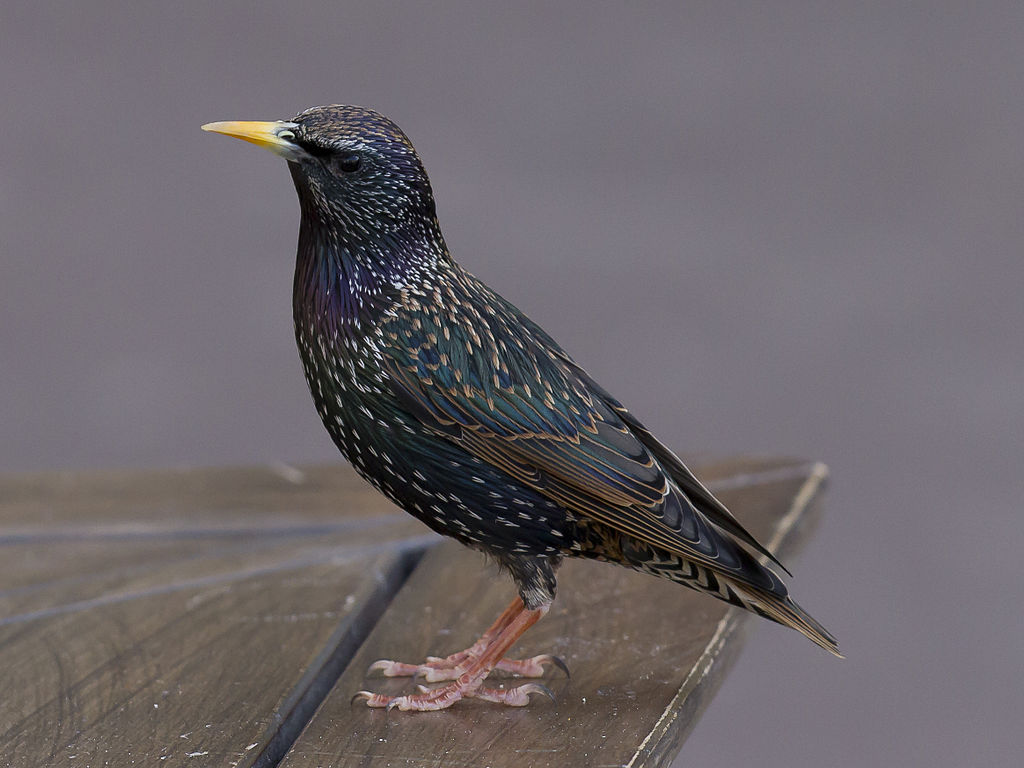
Coloration and Markings: European Starlings look black from a distance but as you get close you’ll see that they are more of a purplish-green and black all over. They have long wings and short tails and facially they have long, straight yellow bills. In the wintertime they make a drastic ‘wardrobe change’ and will appear as brown birds with big, white spots all over. It’s a sight worth seeing and these clever birds can be quite entertaining.
Size: These birds are about the same size as Robins, measuring in 7.9 – 9.1 inches in length with wingspans of 12.5 to 15.8 inches.
Habitat: These are town and country birds, commonly seen on farms and in cities scoping out potential snacks from telephone wires or munching contentedly at backyard feeders. They are not shy about populated areas.
Diet: These birds will eat just about anything but they especially like grains. Try adding wheat, oats, and White Proso millet to the feeder and you’ll see for your own eyes. These birds love will love it!
Supporting Cast (Other Backyard Birds of Illinois That Might Pay You a Visit)
While our year-round birds get the ‘feature’ portion at the beginning of the article, they aren’t the only feathered stars out there to see. The birds that we have listed below are also present for your viewing pleasure at any time of the year. Without further ado we’ll introduce you and tell you what these little guys and gals like:
- Song Sparrow
- American Crow
- Common Grackle
- House Sparrow
- Mourning Dove
Song Sparrow – Melospiza melodia
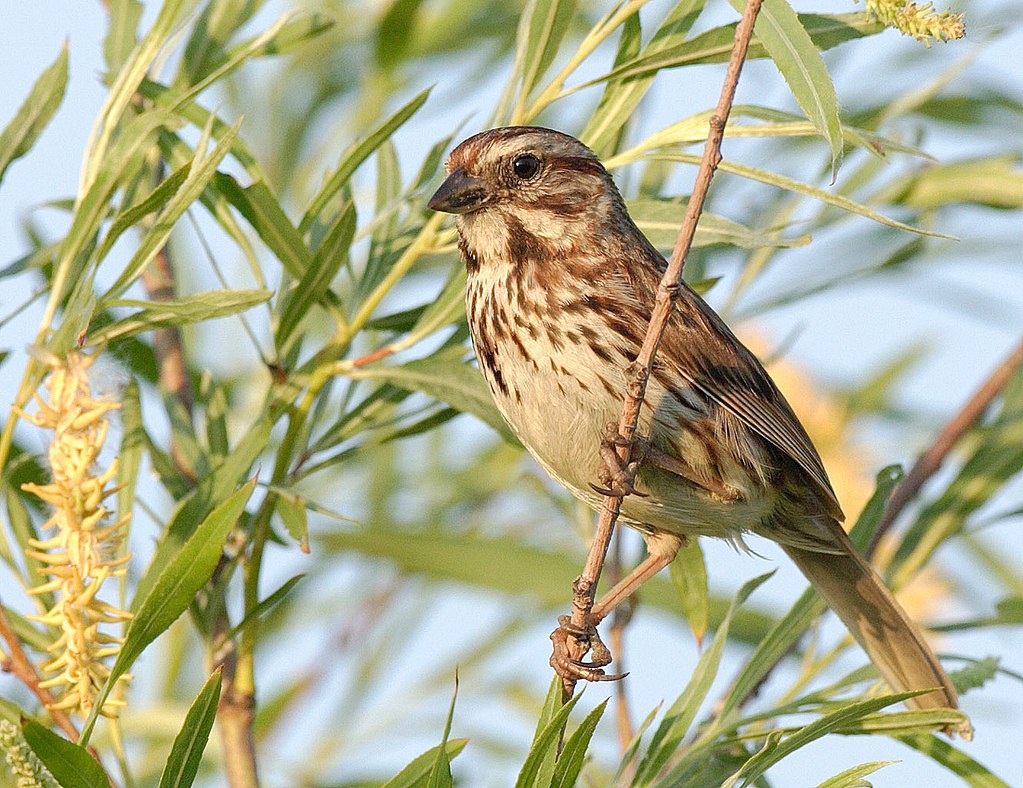
Coloration and Markings: Song Sparrows are delightful little birds that are brown with gray streaks. Their backs are brown-streaked gray and their wings the same, waxing gray at you look to the wingtips. They have long, fanning brown tails and their breast and underbelly is a lighter gray with the same brown streaks as seen on the back. Facially, these birds have brown faces with thick gray lines which typically frame the eye and extend to the back of the head and there is a white ‘mustache’ mark that frames the cheek. This bird has a short, conical gray bill.
Size: These birds measure in at 4.7 – 6.7 inches in length with wingspans of 7.1 to 9.4 inches.
Habitat: These birds love open areas, such as grasslands, fields, and parks and they are also fond of water, spotted often foraging next to ponds or at the edges of marshes. They are avid fans of backyards with feeders as well, so be prepared!
Diet: Seeds and grains are a good bet with Song Sparrows. Add some White Proso millet, wheat, oats, and some chopped cherries or strawberries and you’ll get excellent results with these birds. Assorted dried fruits may also work in a pinch but they like fresh the best.
American Crow – Corvus brachyrhynchos

Coloration and Markings: American Crows are common but fun to watch, due to their bold natures and high intelligence. They are also easy to identify, being completely black except when they are molting, when you might spot a brown feather or two. They have long, fanning tails and large, powerful black bills with a very slight curve to them.
Size: These are large birds, measuring in at 15.8 – 20.9 inches in length with wingspans of 33.5 to 39.4 inches.
Habitat: These birds may be found just about anywhere in a wooded area but they much prefer the city, where you’ll catch them fishing for snacks in dumpers, walking around on sidewalks, or scouting from telephone lines.American Crows aren’t shy in the slightest and a little food can make you a friend, just be sure to stay on their friendly side because these intelligent birds remember faces.
Diet: These birds love human food but it’s not very good for them. You can please them easily with a bowl or feeder full of peanuts instead.
Common Grackle – Quiscalus quiscula
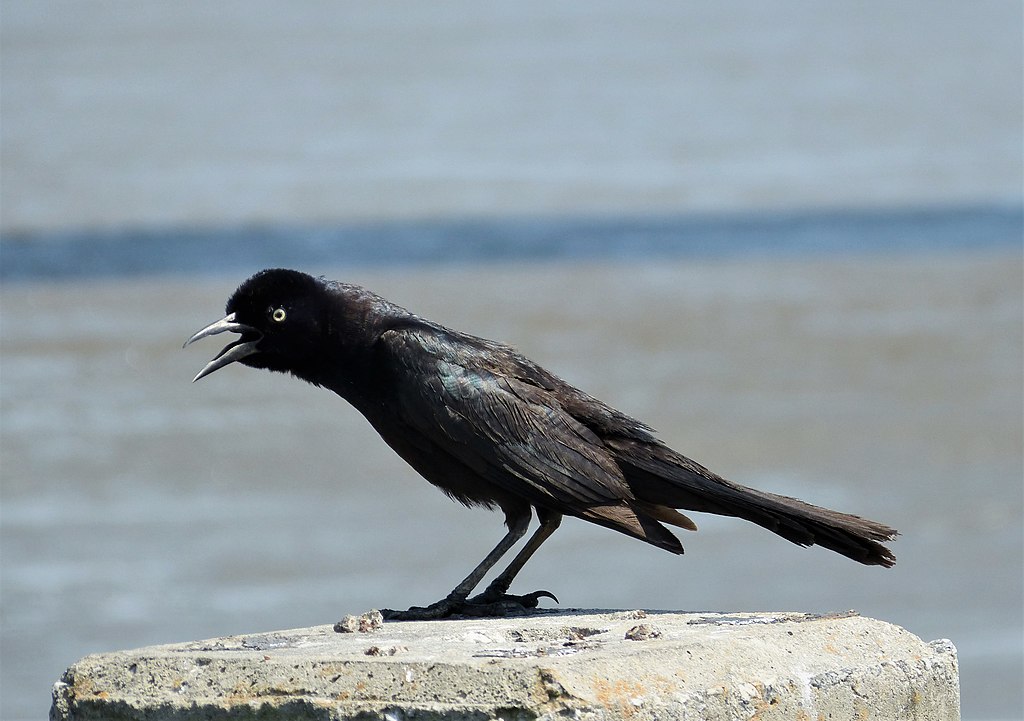
Coloration and Markings: The Common Grackle is pretty and easy to identify. They are a purple and blue all over their bodies and look black until you get a closer peek. Their colorations tends to deeper starting from the breast up, often displaying a higher saturation of blue from here and into the face. They have long wings and medium-sized tails and facially you’ll notice bronze-metallic eyes in front of a long, straight black bill. Females are less shiny and juveniles are brown, with darker eyes.
Size: These birds measure in at 11 – 13.4 inches in length with wingspans of 14.2 to 18.1 inches.
Habitat: Grackles are clever and urbanized, foraging at feeding stations at farms and in cities in parks, dumpsters, gold courses, and anywhere else where people or their waste-food might be left behind. When they are in the woods they like high trees, riversides, and other areas where they can get a good look before they move in for foraging.
Diet: White Proso millet, wheat, oats, and Black Oil Sunflower seeds are all favorites of the bird. Mix at least one grain offering with the seeds for best results.
House Sparrow – Passer domesticus

Coloration and Markings: Male House Sparrows have rich brown coloration on their back, wings, and tail, with some black streaks accenting the color of the wings. They have a ‘dirty’ gray and white breast and underbelly, with some black present in the upper breast as part of a bib that continues as a wide, black stripe up until the bill. The remaining lower portion of the face is white with the exception of the bird’s mask, which is black from bill to the front of the eye, where it becomes brown. After it crosses the eye, the brown continues down and frames the cheek before stopping. The top of this bird’s head is light gray and it has a short, stout and slightly curved black bill.
Size: These Sparrows measure in at 5.9 – 6.7inches in length with wingspans of 7.5 to 9.8 inches.
Habitat: House Sparrows will visit parks and farms but beyond this, they prefer the city to nature. Nesting in buildings, they hang out on roofs, streets, and backyards. They won’t be shy about visiting your feeder if you’ve left them some treats.
Diet: Load your feeder with cracked corn, White Proso millet, and Black Oil Sunflower seeds and you have the recipe for happy House Sparrows.
Mourning Dove – Zenaida macroura
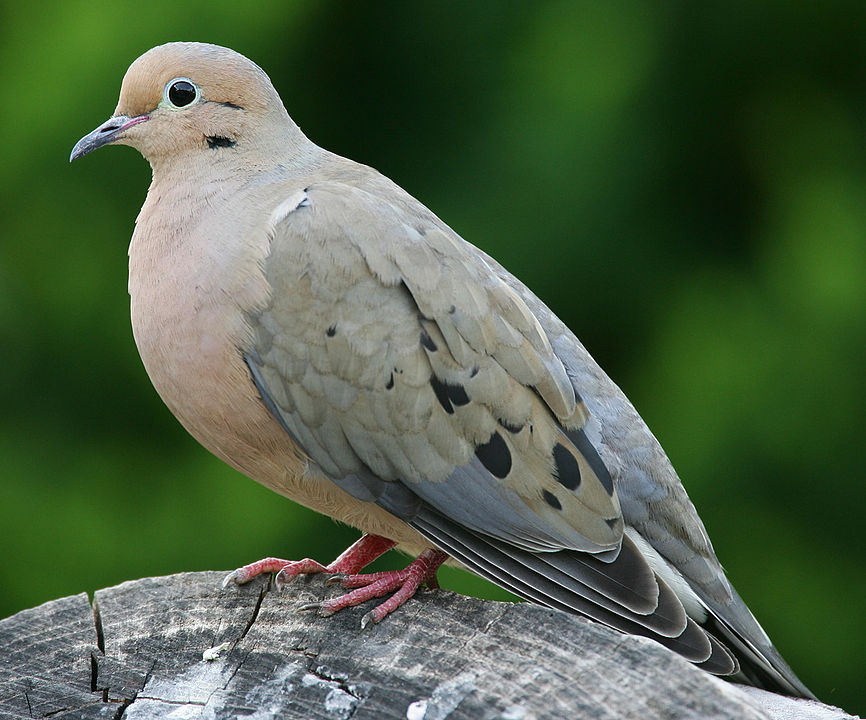
Coloration and Markings: While there is a little regional variation, the Mourning Dove will generally have a soft, gray back and wings, with a large amount of tan centered on each wing as well as distinctive large black spots. They have long, gray tails which are white-in-black at the tips and their breast and underbelly is also a creamy tan and flanked with some white on the sides. Facially, the bird displays its deepest tan coloration and a visible white eyering is present just in front of the short, straight black bill.
Size: These birds measure in at 9.1 – 13.4 inches with wingspans of approximately 17.7 inches.
Habitat: You can see these birds in overgrown fields and even city sidewalks. They are not shy about visiting a town or city. When they are in the woods they tend to stay around the edges but overall they seem to prefer parks and residential areas.
Diet: Black Oil Sunflower seeds mixed with White Proso Millet will make Mourning Doves into happy Doves. Give it a try and see!
Illinois Bird Buffet
If you’d like to set up a feeder to attract the widest range of birds, the Northwest Illinois Audubon Society has some great advice in their article “Choosing the Right Seed’. It can be viewed here: https://www.nwilaudubon.org/support/Choosing%20the%20Right%20Seed.pdf
We’ve taken some highlights to share as well as some recommendations of our own that can help you to build that perfect feeder. Be sure to include one or more of the following:
- Black Oil Sunflower
- Nyjer Thistle
- Striped Safflower
- Cracked Corn
- Suet
- Grape Jelly (birds that love fruit go nuts for this and many birders swear by it!)
Illinois Birding Hot spots
The Chirparazzi are busy snapping shots of the Aerial celebrities all throughout Illinois and you can too, if you just know where to look. Here are some hotspots where you can see some of Nature’s finest for yourself and they are scattered around the compass points and central Illinois so that you can find somewhere convenient and closer to you. We’ve also provided a link for local trails so if one of these doesn’t appeal you can find a more convenient spot, so that the next time you feel like getting out of the house you can do something a little different that you already love. Be sure to visit one of the following sites:
- Northern hotspot – River Trail of Illinois (Carl Bud Schmitt Trail)
- Eastern hotspot – Northerly Island Trail
- Southern hotspot – Ottawa Riverwalk
- Western hotspot – Great River Trail
- Central hotspot – Kishwaukee-Kiwanis Trail
Detailed descriptions of each location as well as information regarding visiting and what birds you can see at these locations may be found at https://www.traillink.com/stateactivity/il-birding-trails/
In Closing
Today we’ve talked about the popular backyard birds of Illinois and we hope that you have enjoyed our time together. Birdwatching is an exciting hobby, there’s just something magical about these agile little feathered friends that can’t help but capture the heart. We hope that these tips will help you to lure more birds to your yard and that we’ve at least piqued your interest with some of the hotspots. In any case, with over 400 birds local to you, we’re sure that you’ll be having a good time birding in Illinois. Until next time, keep those binoculars close and those feeders full!
